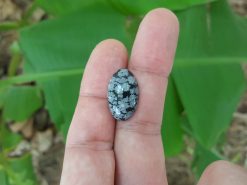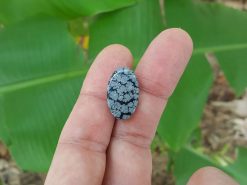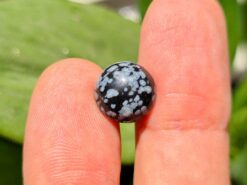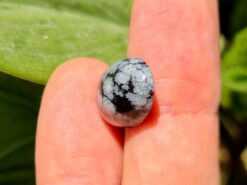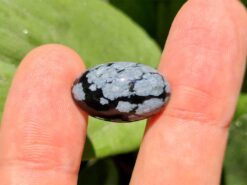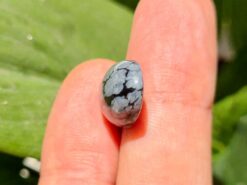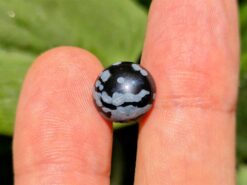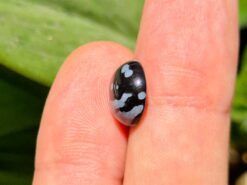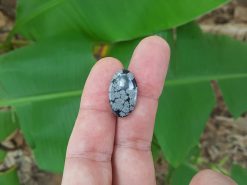Snowflake obsidian
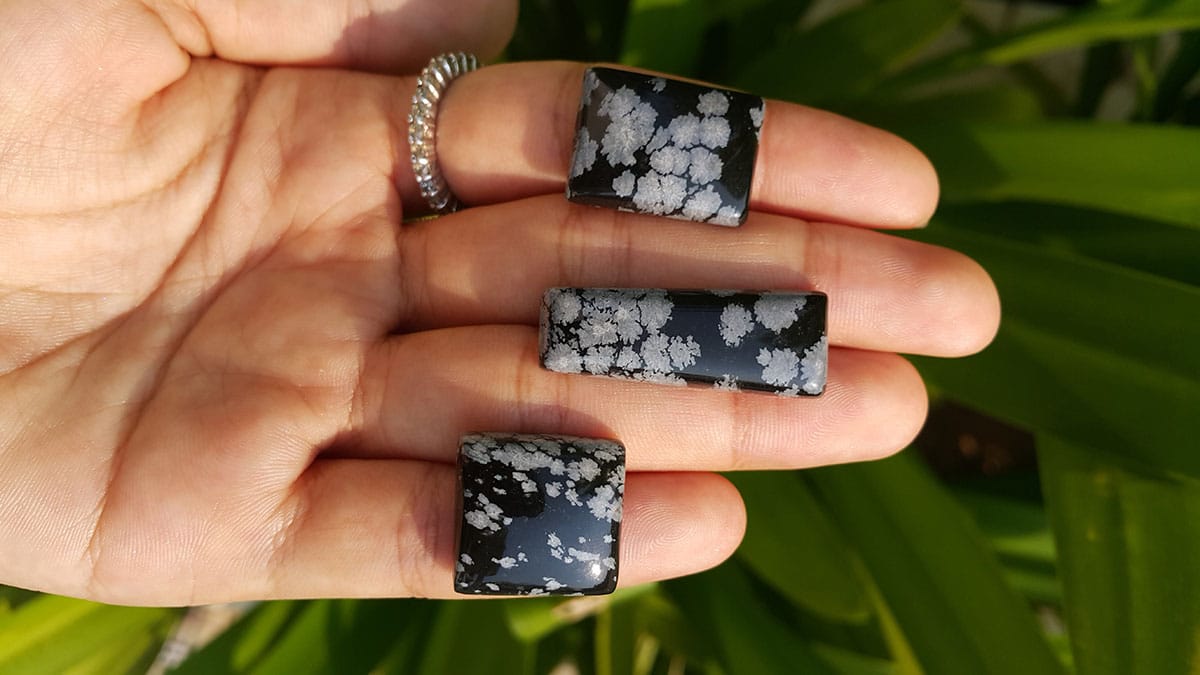
Introduction to Snowflake Obsidian
Snowflake Obsidian, a captivating gemstone with a distinctive appearance, has enchanted collectors, jewelers, and healers for centuries. Its compelling visual appeal comes from a dark, glassy background scattered with white or gray “snowflake” patterns. These markings not only create a unique, eye-catching design but also serve as a testament to the fascinating volcanic processes that gave birth to this stone. In many cultures, Snowflake Obsidian is respected for both its aesthetic beauty and its perceived metaphysical qualities, making it a truly special gemstone to study, wear, or collect.
The Beauty of Snowflake Obsidian
One cannot help but be captivated by the inimitable beauty of Snowflake Obsidian. Each piece boasts a glossy black or dark gray surface adorned with bright, snowflake-like spots. These spots are formed by the mineral cristobalite, which creates delicately shaped flecks that resemble snowflakes gently drifting across a midnight sky. Because these inclusions manifest differently in each specimen, no two stones will look exactly alike, guaranteeing that each Snowflake Obsidian piece is one-of-a-kind.
Beyond its surface appearance, this gemstone also reflects light in a way that accentuates the contrast between its dark background and the radiant inclusions. Whether it’s tumbled, polished, or carved into a unique shape, the natural splendor of Snowflake Obsidian remains mesmerizing. Many individuals appreciate how these contrasting patterns make Snowflake Obsidian a remarkably versatile stone for jewelry, decorative art, and personal collections.
The Geological Formation of Snowflake Obsidian
Like other varieties of obsidian, Snowflake Obsidian originates from volcanic activity. When a volcano erupts, molten lava laden with silica is expelled into the environment. If this lava cools rapidly, the atoms do not have sufficient time to form a crystalline structure, resulting in a naturally occurring glass. With Snowflake Obsidian, this glassy matrix later develops white or light gray splotches of cristobalite, lending the stone its signature snowy patterns.
Volcanic Origins and Rapid Cooling
The formation of Snowflake Obsidian is intimately tied to volcanic processes. Once the lava emerges from the Earth’s depths, it meets the atmosphere and solidifies quickly. This immediate cooling locks in the chemical components, preventing the slow, organized crystal growth seen in other minerals. By analyzing these properties, scientists can learn about the eruption events and cooling environments in which Snowflake Obsidian was formed, offering insight into the geological history of volcanic landscapes.
The Science Behind the Snowflake Pattern
The captivating “snowflake” markings within Snowflake Obsidian are due to the presence of cristobalite. As the glassy material cools and ages, microscopic structures of cristobalite form in radial arrangements. These patterns appear as delicate, branching shapes that mimic the look of falling snow. Their formation is a prime example of nature’s creativity, highlighting how slight variations in temperature and cooling rates can produce visually striking features in volcanic glass.
The Gemological Properties of Snowflake Obsidian
To fully appreciate Snowflake Obsidian, it helps to understand its gemological characteristics. These properties include its hardness, color, chemical composition, and optical behavior. Together, they influence the stone’s wearability, durability, and overall appeal in both jewelry and ornamental applications.
Physical Properties
Snowflake Obsidian exhibits a hardness rating of about 5 to 5.5 on the Mohs scale. While it’s somewhat softer than many other commonly used gemstones, it still offers a reasonable level of durability. Because of its natural formation, Snowflake Obsidian is also relatively resistant to weathering, making it suitable for diverse uses, from delicate carvings to focal points in jewelry.
Color and Appearance
The most recognizable feature of Snowflake Obsidian is its characteristic black or dark-gray color, sprinkled with white “snowflake” crystals of cristobalite. These stark, high-contrast inclusions make each piece stand out, giving the stone a dramatic, almost cosmic appearance. The bold interplay of dark and light is why many people find Snowflake Obsidian irresistible for jewelry and decorative pieces. The classic black backdrop also ensures it complements a wide range of personal styles.
Hardness and Durability
Although Snowflake Obsidian’s hardness ranks 5 to 5.5 on the Mohs scale, which is softer than materials like quartz, it remains tough enough for various design applications. It can be shaped, polished, and crafted into beads or cabochons with relative ease. Nonetheless, due care should be taken to avoid harsh blows or exposure to overly abrasive conditions. With proper handling, Snowflake Obsidian will retain its iconic luster and snowy patterns for years to come.
Chemical Composition and Structure
As a volcanic glass, Snowflake Obsidian is mostly composed of silica (SiO2) along with trace elements like iron and magnesium. These minor components can influence coloration and luster, though the stone’s fundamental appearance primarily arises from its non-crystalline, glassy nature. The quick cooling of lava is what traps these elements in place, resulting in the uniquely smooth, vitreous surface typical of obsidian.
The Role of Cristobalite
The “snowflake” formations within Snowflake Obsidian derive from cristobalite, a mineral that appears under high-temperature conditions. Over time, pockets or clusters of cristobalite grow in a radial fashion, creating the distinctive white, flower-like patches. These inclusions are what make Snowflake Obsidian so visually appealing and differentiate it from other obsidian varieties.
Other Mineral Inclusions
Snowflake Obsidian may also present minor inclusions of minerals like hematite, magnetite, or feldspar. While these inclusions might be less visible to the naked eye, they can subtly affect the stone’s overall coloration or translucency. In every specimen, the interplay of mineral content and volcanic glass contributes to the stone’s singular aesthetic.
Optical Properties
The optical qualities of Snowflake Obsidian stem from its glassy, non-crystalline matrix and the inclusions within. These features give rise to the stone’s luster, opacity, and refractive index, all important factors when identifying and appraising it.
Luster and Transparency
Snowflake Obsidian typically displays a vitreous (glassy) luster. Most specimens are opaque, although thinner edges may allow some light to pass through. The contrast of dark obsidian and white cristobalite inclusions makes the “snowflake” pattern pop even more vividly, providing a stunning effect under bright lighting.
Refractive Index and Specific Gravity
This gemstone usually has a refractive index around 1.50, placing it on the lower end compared to various other gemstones. However, its specific gravity is approximately 2.4, indicating a notable density in hand. When combined with visual features like the “snowflake” spots, these measurable properties can aid in confirming the identity of genuine Snowflake Obsidian.
The Metaphysical Significance of Snowflake Obsidian
In addition to its unique geology, many cultures and modern spiritual practitioners value Snowflake Obsidian for its symbolic and metaphysical attributes. While these beliefs can vary widely, the stone is often associated with themes of balance, protection, and emotional release.
Symbolism and Healing Properties
Snowflake Obsidian is typically linked to concepts of transformation, serenity, and clarity. Some believe that it can help surface unresolved emotional issues, offering users a means to confront and understand them. It’s also regarded as a stone of self-reflection, believed to encourage inner harmony and growth. Whether or not one subscribes to such beliefs, it’s fascinating how Snowflake Obsidian’s physical formation echoes these themes of transformation and revelation.
Emotional Healing and Balance
Crystal enthusiasts and healers often suggest working with Snowflake Obsidian to stabilize and clear the mind. By assisting in the release of stress or negative thoughts, this gemstone may provide an opportunity to reset and refocus on healthier patterns. Many find that simply holding a piece during meditation or placing it in a personal space supports a more balanced, grounded state.
Protection and Grounding
Snowflake Obsidian is also valued as a protective and grounding stone. In certain belief systems, it’s said to form a psychic barrier that repels negative energies. It may also help one remain centered in challenging environments. These qualities have been cherished by different cultures, who recognized Snowflake Obsidian’s importance not just as a physical tool, but also as a spiritual ally.
Snowflake Obsidian in Various Cultures
The historical use of Snowflake Obsidian stretches back to ancient times. Beyond its spiritual applications, it was a practical resource for crafting tools, weapons, and ceremonial objects. This historical interplay of utility and mysticism underlines the stone’s enduring significance.
Native American Traditions
Across various Native American cultures, obsidian was prized for its sharp edges, which made it useful for arrowheads and cutting tools. Snowflake Obsidian’s special pattern added an extra element of intrigue, potentially granting symbolic meaning in ceremonial practices. The stone was believed to offer strength, protection, and a tangible connection to the powerful volcanic forces of the Earth.
Modern Crystal Healing Practices
Today, Snowflake Obsidian remains a favorite among practitioners of crystal healing and energy work. Used in meditative and spiritual routines, it is thought to encourage introspection and the resolution of past traumas or emotional blockages. Its soothing yet introspective nature often makes it a go-to choice for those seeking enhanced mental clarity or personal transformation.
Practical Applications of Snowflake Obsidian
Because of its eye-catching patterns and relative durability, Snowflake Obsidian is found in a multitude of functional and ornamental contexts. Whether in fashion, art, or interior design, this stone’s distinctive contrast adds a touch of natural elegance.
Snowflake Obsidian in Jewelry
Snowflake Obsidian’s black-and-white coloration pairs well with a variety of metal settings, from silver to yellow or rose gold. The stone’s moderate hardness means it can be cut, shaped, and polished into many classic or avant-garde forms. As earrings, bracelets, rings, or necklaces, Snowflake Obsidian offers a stylish statement that effortlessly draws attention.
Care and Maintenance Tips
Though Snowflake Obsidian is somewhat resilient, it’s wise to avoid knocking it against harder surfaces. Wash pieces gently with mild soap and lukewarm water, and always dry them thoroughly. Storing them separately is recommended to avoid accidental scratches from other jewelry. With the right care, Snowflake Obsidian’s glassy surface and magical “snowflake” markings will keep shining.
Popular Jewelry Designs
The versatility of Snowflake Obsidian lends itself to numerous jewelry designs. Beaded necklaces, cuffs, and statement rings frequently feature polished beads or smooth cabochons. Artisans also delight in setting Snowflake Obsidian into intricately carved pendants that highlight the contrast of dark glass and pale flecks. The result is often a stunning piece that easily coordinates with everyday wear or special-occasion outfits.
Snowflake Obsidian in Decorative Art
Beyond jewelry, Snowflake Obsidian makes a wonderful material for decorative art and collectables. From small figurines to grand sculptures, artists have long appreciated how the stone’s contrasting patterns infuse their work with both elegance and mystery.
Carvings and Sculptures
Artisans love working with Snowflake Obsidian to craft ornate carvings or intricate sculptures. The stone’s smooth texture allows for detailed designs, and the snowy inclusions can lend a unique focal point within each piece. Whether it’s a small ornamental item or a grand display piece, Snowflake Obsidian carvings are often cherished for their beauty and craftsmanship.
Home Decor and Accessories
In interior settings, Snowflake Obsidian can serve as a striking accent in items such as bowls, candle holders, or even decorative tiles. Placing a polished slab on a desk or side table can introduce an instant conversation starter. Each piece brings a touch of volcanic artistry into the home, connecting natural elegance with modern design sensibilities.
How to Identify and Purchase Snowflake Obsidian
As with any gemstone, understanding how to differentiate authentic Snowflake Obsidian from imitations is essential. Armed with the right knowledge, you can make informed decisions and confidently choose pieces that best suit your preferences.
Identifying Genuine Snowflake Obsidian
While Snowflake Obsidian’s distinctive “snowflake” inclusions are a strong indicator of authenticity, synthetic imitations do exist. Informed observation and, if needed, professional testing can help ensure you’re getting the real thing.
Visual Identification
A genuine piece of Snowflake Obsidian should exhibit clearly defined white or gray crystal clusters on a dark backdrop. The contrast will vary, but the “snowflakes” generally appear random and naturally scattered. If the pattern seems overly uniform or lacks any variation, it might be a red flag for a lab-created imitation or artificially enhanced material.
Professional Gemological Testing
When in doubt, consider consulting a professional gemologist. They can analyze refractive index, density, and microscopic inclusions to confirm a stone’s identity. This is especially prudent when purchasing higher-value or rare obsidian specimens. Always remember that reputable dealers should be transparent about the origins and quality of their merchandise.
Tips for Purchasing Snowflake Obsidian
Shopping for Snowflake Obsidian can be a rewarding experience if you know what to look for. Examining the stone’s overall appearance, pattern definition, and finish will help you gauge quality. Additionally, research fair pricing ahead of time to avoid overspending.
Evaluating Quality and Price
A premium piece of Snowflake Obsidian typically has distinct, well-distributed inclusions. The surface should be well-polished and free of major scratches or chips. When evaluating price, consider factors such as the stone’s size, clarity, and craftsmanship. While Snowflake Obsidian is not generally expensive compared to rarer gemstones, intricate carving or unique patterns can elevate a piece’s value.
Ethical Considerations
As the demand for ethically sourced gemstones increases, it’s advisable to seek out dealers who prioritize responsible mining and fair labor practices. Legitimate sellers will be forthcoming about their supply chains, ensuring that you can enjoy your Snowflake Obsidian with peace of mind.
Conclusion: The Unique Allure of Snowflake Obsidian
Snowflake Obsidian remains a fascinating gemstone thanks to its unusual formation, striking patterns, and meaningful symbolism. From its fiery volcanic birth to its use in adornments, cultural ceremonies, and holistic practices, it continues to captivate enthusiasts all over the world.
Recap of Snowflake Obsidian’s Unique Features
As a form of volcanic glass, Snowflake Obsidian boasts a brilliant contrast of dark, glossy surfaces against bright cristobalite inclusions. Its moderate hardness and durability make it suitable for a variety of artistic and practical purposes, while its metaphysical associations with clarity, protection, and emotional balance provide additional intrigue for many collectors and spiritual practitioners.
The Enduring Appeal of Snowflake Obsidian
Whether showcased in fine jewelry, displayed as a refined sculptural piece, or simply held during meditation, Snowflake Obsidian continues to demonstrate its timeless allure. Its nature as both a geologic wonder and a symbol of transformation cements its place as a cherished stone across cultures and generations.
References and Further Reading
For those who wish to delve deeper into the world of Snowflake Obsidian, a variety of gemological guides, scientific studies, and cultural sources are available. Exploring these references can provide a comprehensive understanding of its formation, properties, and uses.
Frequently Asked Questions (FAQ) about Snowflake Obsidian
What is the meaning behind the name Snowflake Obsidian?
The name Snowflake Obsidian comes from the distinctive white “snowflake” patterns of cristobalite that stand out against the dark obsidian background, creating a snowy contrast.
Is Snowflake Obsidian a rare gemstone?
Snowflake Obsidian is not particularly rare; it can be found in various regions with volcanic activity. However, pieces with especially attractive or detailed snowflake patterns may be more sought after.
Can Snowflake Obsidian be used for metaphysical purposes without wearing it?
Absolutely! Snowflake Obsidian is often used in meditation, placed around the home, or even held in hand during mindful practices. Its perceived energetic benefits are not limited to wearing it as jewelry.
How can I cleanse and recharge Snowflake Obsidian?
To cleanse this stone, gently rinse it under running water or immerse it in a bowl of water mixed with sea salt. You can also use sage smudging or cleansing incense. Leave it under moonlight or sunlight for a few hours to recharge, or bury it in the Earth for a day.
Can Snowflake Obsidian help with emotional healing?
Many believe Snowflake Obsidian can help release negative emotions and encourage introspection. While experiences vary from person to person, it is commonly regarded as a supportive stone for emotional wellness.
Can Snowflake Obsidian be used for chakra balancing?
Some crystal practitioners associate Snowflake Obsidian with grounding and the Root Chakra. It’s said to help stabilize one’s energy and promote a feeling of being securely rooted.
Is Snowflake Obsidian suitable for everyday jewelry?
Though slightly softer than some other gems, Snowflake Obsidian can still be worn daily with mindful care. Avoid impacts and store it away from harder gemstones that might scratch its surface.
Can Snowflake Obsidian be used in combination with other gemstones?
Certainly. Many designers blend Snowflake Obsidian with other stones to create visually striking or symbolically balanced pieces. However, it’s popular to let Snowflake Obsidian stand on its own to showcase its signature contrast.
Is Snowflake Obsidian associated with any zodiac signs?
Some traditions link Snowflake Obsidian with the Virgo zodiac sign, attributing its grounding and introspective qualities to the analytical and practical nature of Virgo.
Are there any precautions to consider when working with Snowflake Obsidian?
While Snowflake Obsidian is generally safe to work with, always heed personal intuition or comfort levels. If adverse reactions occur, discontinue use. For medical concerns, consult a healthcare professional for proper guidance.
How to cleanse Snowflake Obsidian?
Rinsing it under running water or soaking it briefly in a salted water solution are common methods. You can also smudge it with sage or cleansing incense. Many prefer placing it under the moonlight or sunlight to recharge its energy.
Snowflake Obsidian for Sale
To cleanse Snowflake Obsidian, gently rinse it under running water or immerse it in a bowl of water mixed with sea salt. You can also smudge it with sage or pass it through the smoke of cleansing incense. Recharge the stone by placing it in moonlight or sunlight for a few hours or burying it in the Earth for a day.



